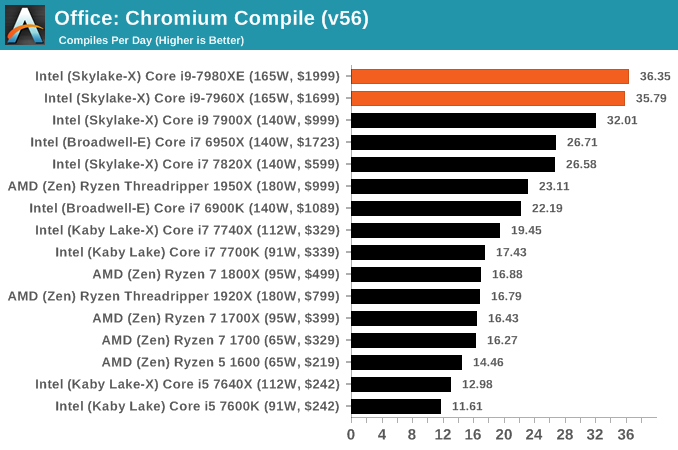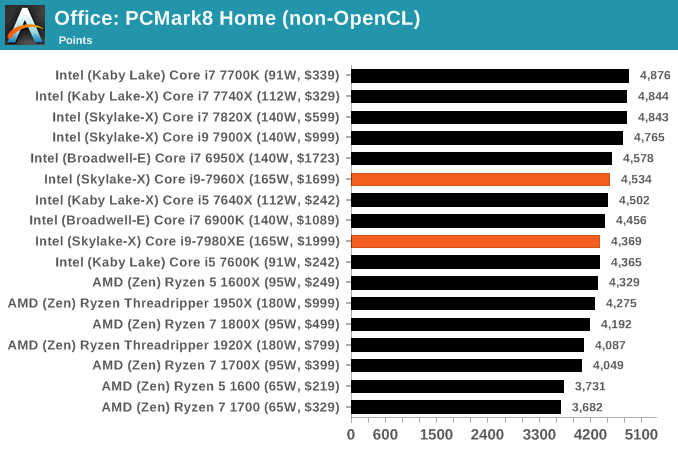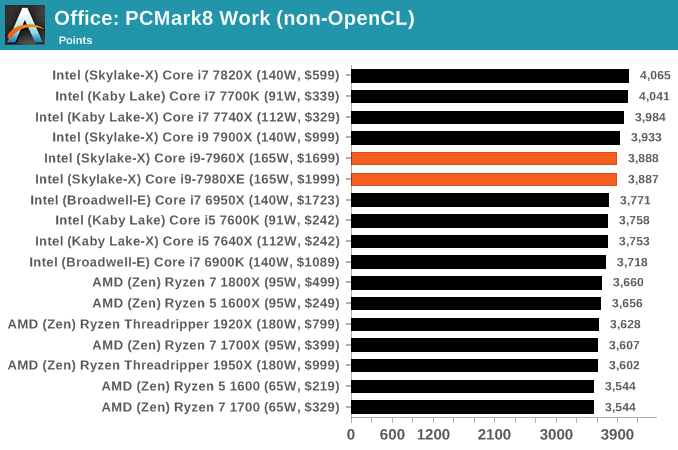The Intel Core i9-7980XE and Core i9-7960X CPU Review Part 1: Workstation
by Ian Cutress on September 25, 2017 3:01 AM ESTBenchmarking Performance: CPU Office Tests
The office programs we use for benchmarking aren't specific programs per-se, but industry standard tests that hold weight with professionals. The goal of these tests is to use an array of software and techniques that a typical office user might encounter, such as video conferencing, document editing, architectural modelling, and so on and so forth.
All of our benchmark results can also be found in our benchmark engine, Bench.
Chromium Compile (v56)
Our new compilation test uses Windows 10 Pro, VS Community 2015.3 with the Win10 SDK to combile a nightly build of Chromium. We've fixed the test for a build in late March 2017, and we run a fresh full compile in our test. Compilation is the typical example given of a variable threaded workload - some of the compile and linking is linear, whereas other parts are multithreaded.

PCMark8: link
Despite originally coming out in 2008/2009, Futuremark has maintained PCMark8 to remain relevant in 2017. On the scale of complicated tasks, PCMark focuses more on the low-to-mid range of professional workloads, making it a good indicator for what people consider 'office' work. We run the benchmark from the commandline in 'conventional' mode, meaning C++ over OpenCL, to remove the graphics card from the equation and focus purely on the CPU. PCMark8 offers Home, Work and Creative workloads, with some software tests shared and others unique to each benchmark set.












152 Comments
View All Comments
CrazyHawk - Tuesday, September 26, 2017 - link
"Intel also launched Xeon-W processors in the last couple of weeks."Just where can one purchase these mythical Xeon-W processors? There hasn't been a single peep about them since the "launch" week. I've only heard of two motherboards that will support them. They seem to be total vaporware. On Intel's own site, it says they were "Launched" in 3Q2017. Intel had better hurry up, 3Q will be up in 4 days!
samer1970 - Tuesday, September 26, 2017 - link
I dont understand why intel disables ECC on their i9 CPU , they are losing low budget workstation buyers who will 100% choose AMD threadripper over intel i9..Even if they are doing this to protect their xeons chips ,they can enable non buffered ECC and not allow Registered ECC on the i9 problem solved. unbuffered ECC has Size limitation and people who want more RAM will go for xeons.
Remember that their i3 has ECC support , but only the i3 ...
intel , you are stupid.
vladx - Wednesday, September 27, 2017 - link
Newsflash, these chips don't target "low budget workstation buyers". Golden rule is always: "If you can't afford it, you're not the target customer.".samer1970 - Wednesday, September 27, 2017 - link
Thats not a Golden Rule anymore with the Threadripper chips around . it is called "Stupid rule" ...They are allowing AMD to steal the low budget workstation buyers by not offering them an alternative to choose from.
vladx - Wednesday, September 27, 2017 - link
The "low budget workstation buyers" as you call them are a really insignificant percentage of an already really small piece of the huge pie of Intel customers.samer1970 - Wednesday, September 27, 2017 - link
who told you so ? Most engineering students at universities need one , and Art Students who render alot as well. all these people will buy threadripper CPU and avoid intel , for intel xeon are 50% more expensive .andI dont cae about the percentage in intel Pie ... hundreds of thousands student enter uiviersites around the world each year . Low percentage or not they are alot ...
how much do you think a low budget workstation costs ? they start from $3000 ... and with xeon Pricing , it will be very difficult to add alot of RAM and a good workstation card and fast SSD .
esi - Wednesday, September 27, 2017 - link
What's the explanation for some of the low scores of the 7980XE on the SPECwpc benchmarks? Particularly Poisson, where the 6950X is 3.5X higher.ZeDestructor - Wednesday, September 27, 2017 - link
Most likely cache-relatedesi - Wednesday, September 27, 2017 - link
Maybe. But one that really makes no sense is the Dolphin 5.0 render test. How can the 7980XE take nearly twice as long as the 7960X?esi - Wednesday, September 27, 2017 - link
So I ran the Poisson benchmark on by 6950X. It uses all 10 cores (20 h/w threads), but can be configured to run in different ways: you can set the number of s/w threads per process. It then creates enough processes to ensure there's one s/w thread per h/w thread. Changing the s/w threads per processes significantly effects the result:20 - 1.34
10 - 2.5
5 - 3.31
4 - 3.47
2 - 3.67
1 - 0.19
Each process only uses about 2.5MB of RAM. So the 1-thread per process probably has a low result as this will result in more RAM usage than L3 cache, whereas the others should all fit in.
Would be interesting to see what was used for the 7980/7960. Perhaps the unusual number of cores resulted in a less than optimal process/thread mapping.